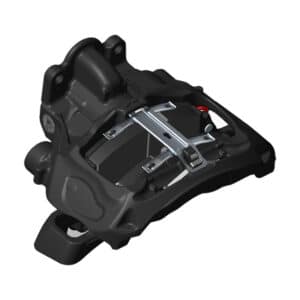Promising results from Lapinus research
In a recent presentation at the 36th Annual Brake Colloquium & Exhibition organized by SAE International in Palm Desert (CA), Fernao Persoon, Manager Application Development Center from Lapinus, addressed one of the biggest challenges of the brake industry and presented an interesting solution Lapinus is investigating.Increased focus
“These emissions will have an increased focus because over the last years the amount of emissions produced by internal combustion engines has been significantly reduced. Therefore, the focus has shifted from engine emissions to non-exhaust emissions such as tire wear, road wear and brake wear,” says Persoon. “This of course will be primarily a concern for cars with an internal combustion engine; obviously, a big part of the kinetic energy of moving electrical cars is used to regenerate the battery during the deceleration process, diminishing the use of brakes. For cars with an internal combustion engine however the demands and legislation concerning brake-wear debris will call for measures by the compounders of brake pad formulas.”You may also like: Lapinus unveils new direction at SAE Brake 2017
In Europe, a working group is currently testing methods to measure and quantify the amount of wear produced by brakes under dynamic conditions. As soon as a standardized measuring method has been approved, European legislation will most likely follow.Innovative concept
During his talk at the SAE, Fernao Persoon presented the results of an exciting new development Lapinus is working on: The application of ‘fibre spheres’ in brake pad formulas. “It’s a preliminary research project,” Persoon emphasizes, “whether it leads to a pilot project or eventually to a tangible product will be decided after we have more test results. And of course, after we have consulted with our customers.” As an innovative player, Lapinus operates at the cutting edge of R&D in the brake pad industry, so the company is used to researching and testing promising new developments, often in collaboration with technical universities or R&D departments of customers. Not all endeavors lead to marketable products, of course, but the concept of fibre spheres embedded in a brake pad looks particularly promising. Lapinus Area Manager Mike Palmen: “A group of major players in the market are challenged to come up with a solution that reduces brake wear debris. Our research showed our fibre spheres had a positive effect on reducing brake wear debris. To what extent our fibre spheres will contribute to that goal we can’t say yet, but it definitely is one development we are keen on taking further.”Fibre spheres collect debris
The concept of fibre spheres first came up after Lapinus researchers saw that mineral fibres of a certain length sometime spontaneously formed what were initially called fibre ‘nests’ when used in brake pad formulas. Esthetically these nests were not an enhancement of the pads, but when studying them intensely in the Lapinus laboratory, a functionality was discovered. This functionality is now being researched in depth with the Technical University of Braunschweig (Germany) amongst others.Capturing debris
At the SAE Brake Colloquium Fernao Persoon elaborated on the spheres’ functionality and the current lab findings. Fernao: “Basically fibre spheres are matrices of entangled mineral fibres. They can form spontaneously in a compound formula. We are now researching how we can engineer them in a controlled way. We test varying sizes and densities in different formulas. The basic functionality of the spheres is that debris from brake pad wear is collected and captured within the spheres instead of being released into the environment.” Besides stabilization of the friction coefficient, this results in a significant reduction of brake pad and rotor wear, and consequently also squeal noise is reduced. The research project is still in its early stages. Not only the intrinsic functionality is being studied, but also the behavior of the spheres in interaction with other components applied in specific formulas.Focus on supporting customers in their market
“Our research department does not aim at introducing new products every year. Our focus is to support our customers in their market with our knowledge and develop long-term solutions for the main challenges they encounter. The fibre spheres may well turn out to be such a solution, but intensive research, testing and piloting will occur before we can conclude if it’s viable to develop a business case around them,” said Palmen.Lapinus, Part of the ROCKWOOL Group At Lapinus, we offer premium quality mineral fibres and strong technical support for the friction industry. We go beyond being a raw material supplier by researching the functionalities of our products together with other materials in the friction matrix. Rising to global challenges for friction, our team has continuously driven innovation for better solutions, together with our customers. Rooted in sustainability, our highly biosoluble products contribute to shaping a better world for today and tomorrow. About ROCKWOOL Group At the ROCKWOOL Group, we are committed to enriching the lives of everyone who comes into contact with our solutions. Our expertise is perfectly suited to tackle many of today’s biggest sustainability and development challenges, from energy consumption and noise pollution to fire resilience, water scarcity and flooding. With approx. 11,000 passionate colleagues in 39 countries, we are the world leader in stone wool solutions, from building insulation to acoustic ceilings, external cladding systems to horticultural solutions, engineered fibres for industrial use to insulation for the process industry and marine & offshore. Source: This article was provided to The BRAKE Report by Lapinus.








